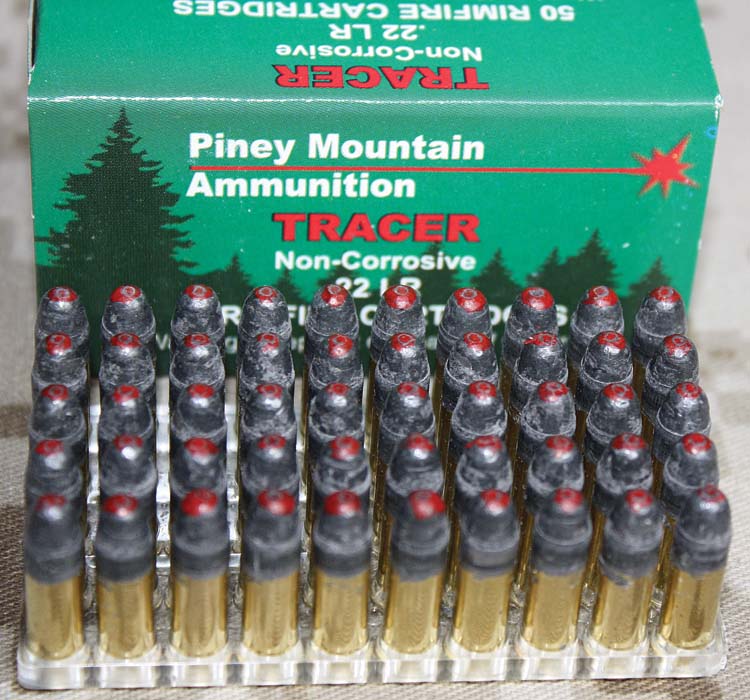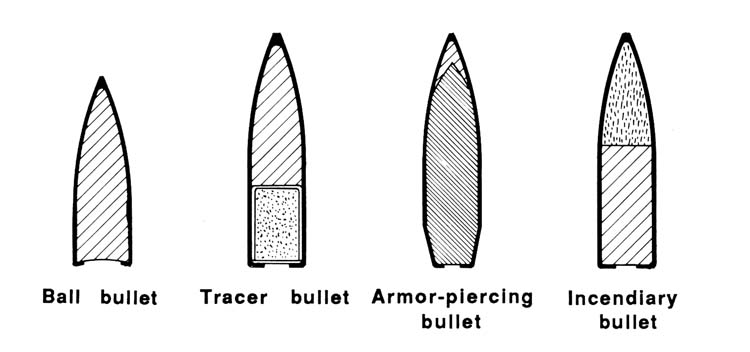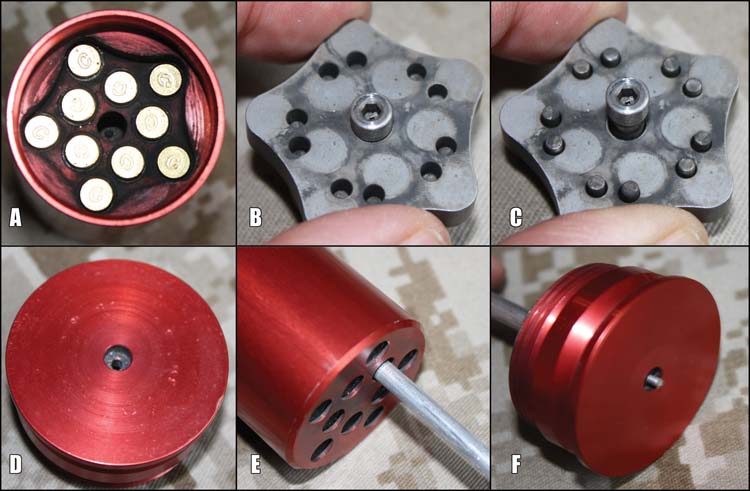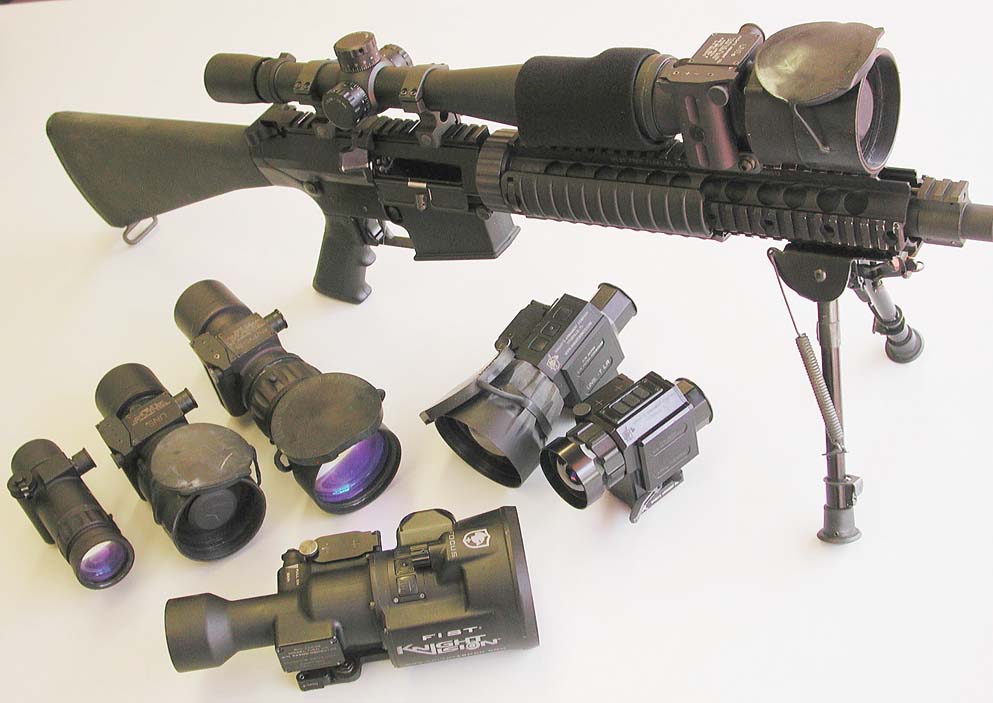Ten rounds of Piney Mountain Tracer ammunition are fired at once from a rail mounted LMT M203 Grenade Launcher mounted under a POF-USA P-416, with the assistance of an Armament Services ‘Hornets Nest’ 40mm/.22 LR subcaliber round.
A tracer round leaving the barrel of a firearm and impacting a target invokes a visual that conjures up all kinds of emotions. Some people recall their time in the Armed Services in places far, far away where they first experienced tracer fire. Some people are reminded of the first movie they saw with bright streaming lights simulating laser beams reaching from the shooter to the intended target. Others recall television footage, new and old, of conflicts covered by the national news. Chances are, if you are reading these pages, although you may be one of the people mentioned above, you are also thinking of the last night shoot you visited or participated in and how much fun tracer ammo is when it can be obtained for a reasonable price and fired safely.
Shooting has always been more of an individual conquest than a spectator sport. To the marksman controlling the trigger it is an opportunity many believe second to none. Building knowledge, experience and technique to improve your performance is a gratifying experience on several levels. To a spouse with other interests, possibly sitting patiently in a vehicle reading a magazine while you are at the range, it can be quite dull to watch or even equivalent to watching paint dry, or so I have been told. Once you add some highly visual or reactive targets to the mix the interest peaks greatly for shooters and non-shooters alike. While some reactive targets like Tannerite Exploding Targets can be great fun, when you add tracer fire, especially in low light to the mix, even people with little to no interest in shooting start to take notice.
While Tracer ammo is not anything new, its introduction into mass produced rimfire ammo is a monumental move. Over the past two decades this writer has been testing firearms and ammo, only a few times has .22 LR ammo been encountered. It was usually very expensive and, for one reason or another, the supply never seemed to last long. When we were approached at SAR Show East and asked if we were interested in testing the Piney Mountain line it was an easy consideration.
As of this writing, we have been testing this ammo for over a year. We have fired it from several platforms and in almost every imaginable weather scenario; all with great success. Though it is manufactured for use primarily in rimfire rifles we have had good luck with many pistols as well. Since the average muzzle velocity is approximately 1,020 feet per second there is little reason to act any different than regular .22 LR ammo, which proved to be correct. There are several videos online where people have been running these in their fully automatic machine guns with great success. There is little that can compare to an American-180 firing in the area of 2,000 rounds per minute of solid tracer. When they are mixed between green and red it only makes it more interesting.

During our testing we fired several rounds through a 40mm/22 LR subcaliber round manufactured by Armament Services International. Billed as The Hornets Nest, this unit is machined from aircraft aluminum and finished in a red anodizing. It fires ten rounds of .22 LR each in their own rifled, steel barrel with a single pull of the trigger in an M203 or M79 40mm Grenade Launcher. Loading it with a mix of the Piney Mountain Tracers soon made it clear why it is marketed as The Hornets Nest. It has a MSRP of $595 and includes the unloading tool. Make sure you have a registered 40mm Destructive Device and not a “flare gun” if you intend to use the Hornets Nest.
While testing the Piney Mountain ammo we had a huge burn rate no matter what the platform was. The rifles traced almost 100% though we noticed a slightly lower burn rate when fired from a pistol. On completely the other side of the spectrum we noticed a 100% burn rate when fired from the 40mm Hornets Nest. The ammo cycled quite well in every firearm we used with some pistols (dirty and cold) getting an occasional short stroke on the ejection. It was easily rectified each time with a simple clearing to the side and re-chambering the following round. While some .22 LR ammo has a greasy or waxy feeling, the Piney Mountain projectile has a solid and dry feel, which will only aid in feeding in some of the more finicky guns.
Not a single round to date has yet to fire as intended so their quality control must be held to a high standard. The vast majority of our testing has been between 50 and 75 yards and all rounds burned the entire way to the backstop. They are rated for 100 yards, plus, and some have reported traces out past 200 yards and even to 300 yards. At our test distances we never had any occasion to witness a “burnout” in our testing.
After the “wow, this is fun” period was in full swing we started thinking of situations where these rounds could have a practical application. They came fast and furious. Since these rounds are visible in all lighting situations they give a clear indication of your point of impact. No guessing when the use of a paper-target and spotting scope are not an option. This writer found them extremely useful in teaching his younger students as well. His 7-year-old son immediately responded well to the use of an occasional tracer or two while shooting to check his point of impact. It can be frustrating for a new, young shooter in hit or miss situations and firing a few tracers can get them back on target in no time. The additional visual is also exciting for new shooters because, well, tracers are just plain fun. From this time on a few boxes will be mandatory in his shooting kit.
Tracer Precautions
Make sure you check your state and local laws about the use and possession of tracer ammunition. At the time of this writing Piney Mountain would not ship tracer ammunition to CA, MA, and NYC and Chicago, IL. All other IL purchasers need an FOID # to buy them.

Other things to consider are the environmental precautions at your range. Very dry areas can produce fires and some areas even have periods during dry weather that may prohibit their use. Our testing took place in Spring, Summer, Winter and Fall and we encountered no problems using a proper sand backstop.
Conclusions
We are very pleased to have met the people at Piney Mountain Ammunition. It may be more expensive than traditional .22 LR ammo but well under the price of center-fire ammo. You can obtain retail and dealer pricing from www.redrimfire.com. It is as fun as it is useful and all who participated in the long-term testing agreed it was money well spent. These rounds are non-corrosive and the tracing element left no damaging residual material in any of the test guns and that is always a subject of concern when tracer ammo is discussed. Their value in training and visual stimulation is worth the price of admission and the fun factor puts them over the top. If you have never been to a night shoot at one of the huge national machine gun shoots and have wondered what the attraction really is, add some Piney Mountain tracer ammunition to your ammo stash and get ready to smile.
Tracer (and other specialty) Ammunition 101
Contrary to popular misconception, a tracer round is much more entailed than a dab of paint on the tip of an ordinary bullet. The paint, coded by different colors is only used to identify the type ammunition. Not all ammunition is color-coded and not all unmarked ammunition is standard ball ammunition. So while we may make assumptions based on this, it is not written in stone. There are many different types of projectiles for modern ammunition including;
- Ball Ammo – Very common solid or jacketed bullet. Ball ammo often has no identifying marks on the projectile.
- Armor Piercing – (AP) – Very similar to ball ammo with the construction of the projectile containing a very hard core inside the jacket. This projectile can be made of hardened steel, tungsten, carbide and in some cases depleted uranium in larger rounds.
- Tracer – (T) While it looks similar to ball ammo from the outside, tracer ammo has a small cup inside the rear of the projectile where a small amount of a flammable chemical is stored and ignited by the initial powder charge. This chemical burns brightly illuminating the trajectory of the fired round.
- Incendiary (I) – Almost opposite in construction of the tracer round, an incendiary round has a small cavity in the front of the projectile containing an incendiary material, which ignites upon impact with the target, flashing and burning very hot.
- High Explosive (HE) – The projectile contains a chamber holding an explosive material and an igniter. HE ammo can be designed to explode on impact or after a delay while still in flight.
- Spotter (or Observation) – The projectile contains a cavity containing a chemical mixture and a front loaded priming device used to estimate distance by producing a flash and smoke when impacting a target.
- Combination Rounds – Many of those listed above can be found in conjunction in a single projectile. Some of the more popular combination rounds include Armor Piercing/Tracer (APT), Armor Piercing/Incendiary (API), Armor Piercing/Incendiary/Tracer (APIT), Incendiary/Tracer (IT) and Spotter/Tracer.
While we realize there are many more types of modern ammunition than listed above, such as blanks, grenade launching blanks, etc., the focus of this article is tracer ammo so we are focusing on those and similar rounds.
Sources
Piney Mountain Ammunition .22lr Tracer Ammo Website: www.redrimfire.com Email: sales@redrimfire.com
Armament Sales International 10-Shot / 40mm Hornets Nest www.autoweapons.com


| This article first appeared in Small Arms Review V14N9 (June 2011) |











